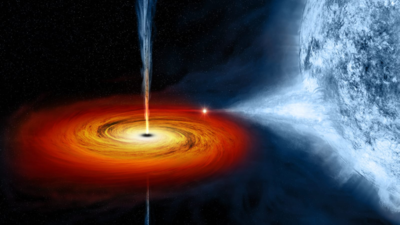A recent study led by researchers at Oxford University Physics provides observational evidence supporting a key prediction from Einstein’s theory of gravity concerning the existence of “plunging regions” around black holes.
Observational Proof
- Source of Evidence: The study, titled “Continuum emission from within the plunging region of black hole discs,” utilized X-ray data from NASA’s NuSTAR and NICER space telescopes to analyze smaller black holes in close proximity to Earth.
- Confirmation: The research confirms the existence of a plunging region around black holes, characterized by some of the strongest gravitational forces observed in the galaxy.
Implications and Future Research
- Significance: This discovery sheds light on fundamental aspects of black hole physics and contributes to ongoing investigations into mysteries surrounding black holes.
- Future Endeavors: Another team from Oxford University Physics aims to capture the first movies of larger, more distant black holes, as part of a European initiative later this year.
Einstein’s Theory vs. Newton’s Theory
- Einstein’s Prediction: According to Einstein’s theory, particles cannot maintain circular orbits sufficiently close to a black hole. Instead, they rapidly “plunge” towards the black hole at speeds approaching that of light, defining the plunging region.
- Contrast with Newton: In contrast, Newton’s theory of gravity does not account for this behavior around black holes.
Researcher Insights
- Dr. Andrew Mummery’s Commentary: Dr. Andrew Mummery, leading the study, emphasized the significance of observing plasma from the outer edge of a star undergoing its final descent into a black hole.
- Analogy: Mummery likened the process to a river transforming into a waterfall, highlighting the transition from observing the river to witnessing the waterfall.
- New Perspective: The study presents a novel approach to investigating the gravitational force exerted by black holes, particularly focusing on the final plunge of matter at the black hole’s edge.
Multiple Choice Questions (MCQs):
- What is the focus of the study led by researchers at Oxford University Physics?
- A) Dark matter observations
- B) Exoplanet exploration
- C) Confirmation of Einstein’s prediction regarding plunging regions around black holes
- D) Exploration of gamma-ray bursts
- Answer: C) Confirmation of Einstein’s prediction regarding plunging regions around black holes
- What observational data did the study utilize?
- A) Radio waves from ground-based telescopes
- B) X-ray data from NASA’s NuSTAR and NICER space telescopes
- C) Infrared imaging from the Hubble Space Telescope
- D) Ultraviolet observations from the International Space Station
- Answer: B) X-ray data from NASA’s NuSTAR and NICER space telescopes
- How does Einstein’s theory of gravity differ from Newton’s theory concerning black holes?
- A) Einstein’s theory predicts the existence of plunging regions, while Newton’s theory does not.
- B) Newton’s theory predicts the existence of event horizons, while Einstein’s theory does not.
- C) Einstein’s theory predicts the existence of wormholes, while Newton’s theory does not.
- D) Newton’s theory predicts the existence of Hawking radiation, while Einstein’s theory does not.
- Answer: A) Einstein’s theory predicts the existence of plunging regions, while Newton’s theory does not.
- What analogy did Dr. Andrew Mummery use to describe the observed process?
- A) A meteor shower
- B) A solar eclipse
- C) A river turning into a waterfall
- D) A lightning storm
- Answer: C) A river turning into a waterfall
